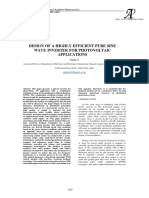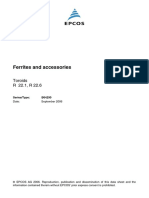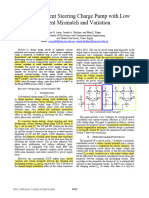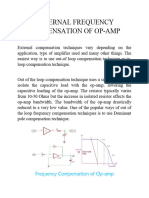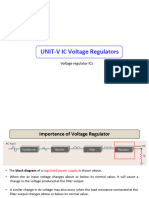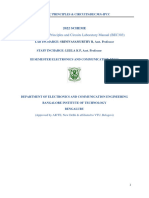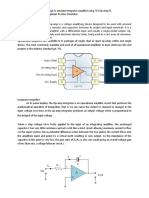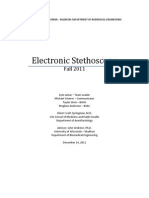Synchronised Linear Ramp-Pulse Based Triggering Pulse Generation ON/OFF Control For Solid-State Switches: Capacitor Switching Applications
Synchronised Linear Ramp-Pulse Based Triggering Pulse Generation ON/OFF Control For Solid-State Switches: Capacitor Switching Applications
Uploaded by
Beny StephenCopyright:
Available Formats
Synchronised Linear Ramp-Pulse Based Triggering Pulse Generation ON/OFF Control For Solid-State Switches: Capacitor Switching Applications
Synchronised Linear Ramp-Pulse Based Triggering Pulse Generation ON/OFF Control For Solid-State Switches: Capacitor Switching Applications
Uploaded by
Beny StephenOriginal Description:
Original Title
Copyright
Available Formats
Share this document
Did you find this document useful?
Is this content inappropriate?
Copyright:
Available Formats
Synchronised Linear Ramp-Pulse Based Triggering Pulse Generation ON/OFF Control For Solid-State Switches: Capacitor Switching Applications
Synchronised Linear Ramp-Pulse Based Triggering Pulse Generation ON/OFF Control For Solid-State Switches: Capacitor Switching Applications
Uploaded by
Beny StephenCopyright:
Available Formats
See discussions, stats, and author profiles for this publication at: https://www.researchgate.
net/publication/266345283
Synchronised Linear Ramp-Pulse Based Triggering Pulse Generation ON/OFF
Control for Solid-State Switches: Capacitor Switching Applications
Article in WSEAS Transactions on Power Systems · April 2012
CITATION READS
1 1,786
2 authors, including:
Subramanian Kulandahivelu
Vellore Institute of Technology, Vellore, India
24 PUBLICATIONS 58 CITATIONS
SEE PROFILE
Some of the authors of this publication are also working on these related projects:
Now i am doing filter design for ASD View project
All content following this page was uploaded by Subramanian Kulandahivelu on 28 October 2014.
The user has requested enhancement of the downloaded file.
WSEAS TRANSACTIONS on POWER SYSTEMS K. Subramanian, K. K. Ray
Synchronised Linear Ramp-Pulse Based Triggering Pulse Generation
ON/OFF Control for Solid-State Switches: Capacitor Switching
Applications
K.SUBRAMANIAN1 AND K.K.RAY
Power Electronics and Drives Division
Vellore Institute of Technology University
Vellore, Tamil Nadu, 632 014
INDIA
1
Email id: ksubramanian@vit.ac.in
Abstract: -Thispaper describes a newly developed triggering circuit, has been use to turn on and off the solid-
state switches, such as TRIAC switched capacitors applications. A linear ramp signal based synchronization
technique has been propose and implemented successfully, for the capacitor switching operation of a simple
power system. This scheme enables the firing circuit to adjust itself against any phase and/or sequence
alterations. This feature leads to elimination of the phase locked-loop (PLL) control, are commonly used to
synchronize the pulse generations with respect to the system the supply frequency. Those pulses are, to control
the converter / inverter operation of an industrial drives and the FACTS controllers also. The proposed circuit
has been constructing and tested experimentally in the laboratory. The simulation work completed using Or
CARD software. The result shows a good agreement with the theoretical waveforms.
Key Words: - linear ramp signal, synchronization, capacitor switching
1 Introduction has been detected and to fix the frequency reference.
L.S.Torseng [4] discussed the reactive power
In electrical drives applications either in compensation of a power system by thyristor
industries or in elsewhere, induction motors are switched capacitors (TSC) and thyristor controlled
widely used. Therefore, the system has a low power reactor (TCR) schemes. In view of capacitor
factor. The shunt-connected capacitors are widely switching operation, T.J.E Miller [5] and N. H.
used to improve the power factor. In addition to Hingorani et al [6] have discussed the constraints
that, shunt capacitors have been to regulate the and control strategy.
voltage of the transmission line at the receiving end. In case of stand-alone power generators, such as
In earlier days, mechanical switches used to connect self-excited induction generator, excitation control
the capacitor in aforementioned applications. After says, either adding or removing the capacitor to the
the development of power semiconductor devices stator windings of the generators. T.A. Ahemed et al
with higher power handling capabilities and current [7] discussed the terminal voltage regulation of a
ratings, solid-state switches (like thyristors, IGBT, three-phase capacitor excited induction generator
GTO, MOSFET, TRIAC etc..) are used instead of using switched capacitor and fixed capacitor-
mechanical switches, because of its compactness thyristor controlled reactor with zero crossing
and easy to control. technique. In single-phase generator, also the same
Static power conversion manufacturers have technique has been implemented [8]. Ebenezer
developed a variety of thyristor firing circuits based Prates Da Silveira et al. [9] describe the low cost
on commercially available discrete and integrated optical TRIAC with a built in zero-crossing function
circuits. Ainsworth [1] has presented a phase locked based voltage regulation of three phase induction
oscillator control system for thyristor-controlled motor with direct on line staring.
reactor. Frank J. Bourbeau [2] developed, LSI based However, aforementioned applications need a
three-phase thyristor firing circuit insensitivity to separate control, to synchronize the frequency and
frequency and direction of phase rotation with PLL pulse generations. The aim of this work, propose a
circuit. A microprocessor based firing circuit for new technique, can be automatically synchronised
thyristors working under a three-phase variable with supply frequency variations. Analog and digital
frequency supply has been suggest and implemented integrated circuit based triggering pulse generation
by H. M. EL Bolok [3]. In his work, zero crossing circuit (with less number of component) has been
E-ISSN: 2224-350X 45 Issue 2, Volume 7, April 2012
WSEAS TRANSACTIONS on POWER SYSTEMS K. Subramanian, K. K. Ray
develop and tested in the laboratory.
2 Proposed Triggering Circuit
The proposed triggering circuit, shown in Fig.1,
consist of a single-phase full bridge diode rectifier,
ramp pulse generator, comparator, edge detector,
opto coupler and buffer circuit.
Fig.3. single line diagram of variable frequency generator with
load and TRIAC switched capacitor
3. 1 Full bridge rectifier
Fig.3 (a) depicts the full bridge rectifier,
consists of a shunt-connected transformer, two
diodes D1 and D2 connected in secondary windings
Fig.1 Proposed triggering pulse generation circuit for ON/OFF of the transformer. Load voltage of 230V (line-to-
control of TRIAC switch neutral) applied to the transformer primary as shown
Descriptions of the individual blocks have been in Fig.3 (b). The secondary voltage of 12V, ac (feed
discusses in sub-sequence paragraphs in details. back signal) rectified by the diodes (as shown in
Fig.2 illustrates the typical waveform of the Fig.3(c), and, feeding to the next stage of constant
triggering circuit at different points, had been used current source.
for TRIAC switch ON/OFF control.
Fig.3 full bridge diode rectifier (a) circuit connection (b)
simulated input voltage (c) rectified voltage waveforms
Fig.2 Typical waveform of proposed triggering circuit
3. 2 Ramp Signal Generation
3 Principle of operation The base of the transistor Q1 biased by the
Fig.3. shows a 3-Ø inductive load powered from rectifier voltage using 4.7 kΩ resistance (R1) if the
a variable frequency, capacitor excited induction base voltage, above 0.7 V, Q1 conducts and the
generator. Low-level voltage signal of load voltage collector to emitter voltage is zero. When base
has taken from the load terminal, feeding to the voltage is between 0V and 0.7V, Q1 is OFF,
triggering pulse generation circuit. therefore, 12V dc, divides between 2.2 kΩ (R2) and
4.7 kΩ (R3) resistances. The collector to emitter
E-ISSN: 2224-350X 46 Issue 2, Volume 7, April 2012
WSEAS TRANSACTIONS on POWER SYSTEMS K. Subramanian, K. K. Ray
voltage waveform of Q1 is showing in Fig. 4(b). positive saturation voltage of the op-amp. As soon
This voltage applied to the base of Q2. This causes as the instantaneous value of the ramp becomes
Q2 to turn on when Q1 is off and to turn off when more than the reference dc voltage, the output goes
to negative saturation voltage of the op-amp, thus a
Q1 is on. The collector to emitter voltage waveform
square wave (as shown in Fig. 5(c)) produced. The
of Q1 is showing in Fig.4 (b). Resistors on time of the square wave, varies by changing the
R 5 and R 6 form a voltage divider bias for transistor value of the reference dc voltage.
Q3. The base voltage of Q3 varies by varying the The output of the op-amp applied as an input to
resistor R 6 . It is adjusted such that Q3 conducts the edge detector IC. Since it is a digital IC, a
maximum of 5 volts is allowing to its input
always, thus charging the capacitor C3. However, at
terminals. Therefore, 4.7V zener diode (02DZ4.7)
the end of each half cycle, when voltage is going
has been connecting in front of the edge detector
from 0.7V to 0V, Q2 conducts hence discharging the
circuit. Fig.5(c) shows the square wave, which is
capacitor to ground. This charging and discharging
the output of zener diode terminal.
in each half cycle produces a ramp wave. It is
showing in Fig.4(c) along with the full wave
rectified sine wave to show the synchronization of
the ramp with the input supply.
Fig.5 (a) Input signals to op-amp; (b) Output of op-amp;
(c) Output at zener diode
Fig.4 constant current source (a) circuit connection (b)
simulated collector-to-emitter voltage of transistor Q1 (c)
corresponding ramp signal 2. 4 Edge Triggering
The advantages of this firing circuit are to An IC of DM74121, used as edge detection
generate a linear and synchronised ramp wave circuit as shown in Fig.6 (a). The IC could detect
generation and self-adjust the firing instant with both positive (rising) and negative (falling) edges,
frequency variation, therefore, no need of separate depending on the mode of operation. The negative
synchronism control loop. Any change in frequency edge-triggering scheme chosen (Fig.6 (a)), for that,
of the input signal will cause a corresponding an external connection has been modifying by using
change in the period of the ramp. This can be the logic shown in Fig.6 (b).
eliminating the phase locked loop (PLL) adjustment IC DM74121 is a monostable multi-vibrator
usually needed due to synchronise the firing signal featuring both positive and negative edge triggering
generation with frequency variations. with complementary outputs. An internal 2kΩ
timing resistor is using to design convenience
2. 3 Comparator Circuit minimizing component count and layout problems.
An integrated circuit (IC) of uA741 operational- This device could be use with a single external
amplifier (op-amp) has been used as comparator as capacitor. Inputs (A) are active-LOW trigger
shown in Fig.5 (a). The synchronised ramp wave transition inputs and input (B) is an active-HIGH
and reference signal are given to the inverting transition Schmitt trigger input that allows jitter-free
terminal and non-inverting terminal of the op-amp triggering from inputs with transition rates as slow
respectively. +12V DC is given to the seventh pin as 1 volt/second. A high immunity to VCC noise of
and -12V DC is given to the fourth pin of the op- typically 1.5V is providing by internal circuitry at
amp. The op-amp compares the ramp with the the input stage. The main features of the IC are, can
reference signal as shown in Fig.5(b). When the be triggered from active-HIGH transition or active-
instantaneous value of the ramp is lower than the LOW transition inputs; the pulse width can be
reference signal, the output of the op-amp goes to varied from 30 ns to 28 seconds; excellent noise
E-ISSN: 2224-350X 47 Issue 2, Volume 7, April 2012
WSEAS TRANSACTIONS on POWER SYSTEMS K. Subramanian, K. K. Ray
immunity of typically 1.2V; Stable pulse width up 3-Ø triac switched capacitor (shown in Fig.7 with in
to 90% duty cycle. The function of the IC is as a circle). The capacitor current shows harmonics, it
given in Fig. 6 (b). Here, the first mode has been will be eliminates by introducing a small value of
choosing where the inputs A1 and B are high and a inductor in series with capacitor.
negative edge is giving to the input A2. This
produces a positive pulse at the output Q and a
negative pulse Q . The output at Q used for the next
stage. The pulse width is keeping at three
milliseconds by adjusting the external resistor. The
reason is that to fire the TRIAC in series with the
capacitor, in TSC, at least 30% on-time pulse is
required. Fig.6(c) shows the output of DM74121.
Fig.6 Edge triggering scheme (a) connection diagram (b) logic
for connection (c) output waveform
4 Experimental Work
To validate the proposed triggering circuit,
a 240V, 4,7A, capacitor excited induction generator
(as shown in Fig.3 single line diagram) rig up in the
laboratory, generates the voltage with variable
frequency. A TRIAC switched capacitor used as a
Fig.8 experimental results of self-synchronizations with a
voltage regulator. frequency of (a) -50 Hz (b)- 55 Hz (c) -45 Hz
5 Conclusions
The proposed triggering circuit has been
constructing tested, as a voltage regulator of a 3-Ø
self-excited induction generator. The observations
are
TRIAC switch goes to OFF state suddenly
(shown in Fig.9) after turn ON, in addition
negative half-cycle capacitor current goes to
zero values.
A pure capacitor connection generates a
Fig.7 experimental results harmonics and huge amount of capacitor
Fig.7 illustrates the capacitor voltage, currents are presents.
capacitor current and triggering pulse, captured
during the experimental work. A single leg of a
E-ISSN: 2224-350X 48 Issue 2, Volume 7, April 2012
WSEAS TRANSACTIONS on POWER SYSTEMS K. Subramanian, K. K. Ray
Phase Self-Excited Induction Generator”, IEE
Proc. C, Vol. 152, No. 2, pp. 145-156.
[9] Ebenezer Prates da Silveira, Robson Celso
Pires,Antonio Tadeu Lyrio de Almeida ,Angelo
José and Junqueira Rezek, “ Direct On Line
Starting Induction Motor With Thyristor
Switched Capacitor Based Voltage
Regulation”, Conference Proceeding, log no.
978-1-4244-3370-4/09, 2009, pp 1124 -1129.
[10] Or CAD software package
Fig.9 First stage test result of TRIAC switched capacitor
I would like to thanks my doctoral committee
member’s suggestions, to eliminate the problem
shown in Fig.9, by modification of the triggering
circuit shown in Fig.1.
References:
[1] Ainsworth, “Phase Locked Oscillator Control
System for Thyristor Controlled Reactors”,
IEEE Transaction on Power Apparatus and
Systems, Vol. PAS-103, No.1, January 1984, pp
198 – 212.
[2] Frank J. Bourbeau, “LSI based three-phase
thyristor firing circuit”, IEEE Transactions on
Industry Applications, Vol.9, No.4, July /
August 1983, pp.571-578.
[3] H. M. EL. Bolok, “A Microprocessor Based
Firing Circuit for Thyristors Working under a
Tree-Phase Variable Frequency Supply”, IEEE
Transactions on Industrial Electronics, Vo37,
No.2, April 1990, pp.152-155.
[4] S. Torseng, Shunt connected reactors and
capacitors by thyristors”, IEEE Proc.
November 1981, pp 366-373.
[5] T. J. E. Miller, “Reactive Power Control in
Electric System”, John Willey & Sons 1982.
[6] N. G. Hingorani, “Power Electronics in Electric
utilities: Role of Power Electronics in Future
power Systems”, Proceeding of the IEEE, April
1988.
[7] T.Ahmed, O. Noro, E. Hiraki and M. Nakaoka,
“Terminal Voltage regulation Characteristics
By Static VAr Compensator For A Three-Phase
Self-Excited Induction Generator”, IEEE
Transactions on .Industry Applications, Vol.
40, No. 4., 2004, pp. 978-988.
[8] T. Ahmed., K. Nishida., K. Soushin and M.
Nakaoka, “Static VAR Compensator-Based
Voltage Control Implementation of Single-
E-ISSN: 2224-350X 49 Issue 2, Volume 7, April 2012
View publication stats
You might also like
- Comparison Between LCC and VSCDocument5 pagesComparison Between LCC and VSCijsretNo ratings yet
- Peavey Escort 2000Document24 pagesPeavey Escort 2000Alex Zparta100% (1)
- Shunt Reactor SizingDocument4 pagesShunt Reactor Sizingrajfab100% (5)
- 2016 - 10 - A Simple Gate-Pulse Generating Circuit For Single-Phase Line-Commutated Thyristor ConverterDocument5 pages2016 - 10 - A Simple Gate-Pulse Generating Circuit For Single-Phase Line-Commutated Thyristor Converterdanilonobre3508No ratings yet
- Inrush Current TestingDocument8 pagesInrush Current TestingRXRSNo ratings yet
- Impact - of - Grading - Capacitor - On - Transient Recovery Voltage During Switching Out of Shunt ReactorDocument8 pagesImpact - of - Grading - Capacitor - On - Transient Recovery Voltage During Switching Out of Shunt Reactorchandraippa2No ratings yet
- Three Phase20three Level20voltage20source20inverterDocument6 pagesThree Phase20three Level20voltage20source20inverterfarid kerroucheNo ratings yet
- Unit 04Document19 pagesUnit 04JayaprakashamNo ratings yet
- Steady-State Analysis of An Interleaved Boost Converter With Coupled InductorsDocument9 pagesSteady-State Analysis of An Interleaved Boost Converter With Coupled InductorsSasanga HewagamaNo ratings yet
- 41 - Unity Power Factor Isolated Three-Phase Rectifier With Split Dc-Bus Based On The Scott TransformerDocument10 pages41 - Unity Power Factor Isolated Three-Phase Rectifier With Split Dc-Bus Based On The Scott Transformergerson gomesNo ratings yet
- 5 106-6 PDFDocument6 pages5 106-6 PDFCeh DjamelNo ratings yet
- A Novel Single-Stage Full-Bridge Buck-Boost InverterDocument10 pagesA Novel Single-Stage Full-Bridge Buck-Boost InverteriiscgovindraiNo ratings yet
- One-Cycle-Controlled Bidirectional AC-to-DC Converter With Constant Power FactorDocument12 pagesOne-Cycle-Controlled Bidirectional AC-to-DC Converter With Constant Power FactorKrishna ReddyNo ratings yet
- Voltage Regulation of 3-Ø Self Excited Asynchronous GeneratorDocument10 pagesVoltage Regulation of 3-Ø Self Excited Asynchronous GeneratorReda LQddiemeNo ratings yet
- 19 Jay PrakashDocument6 pages19 Jay Prakashhimanshupatlan191No ratings yet
- Evaluating Voltage Notch Problems Arising From AC/DC Converter OperationDocument9 pagesEvaluating Voltage Notch Problems Arising From AC/DC Converter Operationmeistehaft270No ratings yet
- Steady-State Analysis of An Interleaved Boost Converter With Coupled InductorsDocument9 pagesSteady-State Analysis of An Interleaved Boost Converter With Coupled InductorsNanda AzizahNo ratings yet
- A New Transformerless Single-Phase Buck-Boost AC Voltage RegulatorDocument6 pagesA New Transformerless Single-Phase Buck-Boost AC Voltage Regulatordinhngock6No ratings yet
- Simulations and Experimental Verification of An All-Active Hybrid Converter Arrangement For Filtering Power System Harmonics andDocument6 pagesSimulations and Experimental Verification of An All-Active Hybrid Converter Arrangement For Filtering Power System Harmonics andshiks16No ratings yet
- Speed Control of Separately Excited DC Motor Using Power Electronic ConverterDocument5 pagesSpeed Control of Separately Excited DC Motor Using Power Electronic ConverterIJIERT-International Journal of Innovations in Engineering Research and Technology100% (1)
- Feasible Performance Evaluations of 3-Level 3-Phase Voltage Source Soft-Switching Inverter Using IGBT ModulesDocument6 pagesFeasible Performance Evaluations of 3-Level 3-Phase Voltage Source Soft-Switching Inverter Using IGBT ModulesharoutuonNo ratings yet
- Single Phase AC To AC Conversion Without Frequency RestrictionsDocument4 pagesSingle Phase AC To AC Conversion Without Frequency RestrictionsTaniyaNo ratings yet
- OhnumaDocument7 pagesOhnumaHiển TrầnNo ratings yet
- Screenshot 2023-08-25 at 5.36.31 PMDocument111 pagesScreenshot 2023-08-25 at 5.36.31 PMameralmajali123No ratings yet
- MainDocument6 pagesMainRaviraj KumbharNo ratings yet
- Zero-Voltage Switching For Three-Level Capacitor Clamping InverterDocument11 pagesZero-Voltage Switching For Three-Level Capacitor Clamping InverterTiền Hoàng VănNo ratings yet
- IJEDRCP1402017Document4 pagesIJEDRCP1402017anas maraabaNo ratings yet
- 29-04-2021-1619695048-6-Ijeee-2. Ijeee - Power Quality Improvement Using Fuzzy Based StatcomDocument10 pages29-04-2021-1619695048-6-Ijeee-2. Ijeee - Power Quality Improvement Using Fuzzy Based Statcomiaset123No ratings yet
- Adeoye Journal 4.Document10 pagesAdeoye Journal 4.OJO JoshuaNo ratings yet
- Lab2 Eeb 451Document6 pagesLab2 Eeb 451tetojogoldenboyNo ratings yet
- Electric Vehicle - Design and Implementation Strategies For The Power TrainDocument7 pagesElectric Vehicle - Design and Implementation Strategies For The Power TrainkamaleshsNo ratings yet
- Transformer Based Resonant DC Inverter For Brushless DC Motor Drive SystemDocument7 pagesTransformer Based Resonant DC Inverter For Brushless DC Motor Drive SystemStudents Xerox ChidambaramNo ratings yet
- Multi Level Three-Phase InverterDocument11 pagesMulti Level Three-Phase InverterJavier RuizNo ratings yet
- Badin 2011Document9 pagesBadin 2011gerson gomesNo ratings yet
- Studies On Transients in High Voltage Line: Experimental and Simulation ResultsDocument7 pagesStudies On Transients in High Voltage Line: Experimental and Simulation ResultsSaibal ChatterjeeNo ratings yet
- Power Quality Improvement of Unified Power Quality Conditioner Using Reference Signal Generation MethodDocument5 pagesPower Quality Improvement of Unified Power Quality Conditioner Using Reference Signal Generation MethodSurya Ch VenkataNo ratings yet
- GL in Kowski 1997Document8 pagesGL in Kowski 1997alvarofranciscooliveiraNo ratings yet
- Angle Controlled Current Regulated Rectifiers For AC/AC ConvertersDocument7 pagesAngle Controlled Current Regulated Rectifiers For AC/AC ConvertersKanomba JavaNo ratings yet
- A Novel Method of Overvoltage Suppression Due To De-Energization of Shunt Reactor in High Voltage SystemDocument14 pagesA Novel Method of Overvoltage Suppression Due To De-Energization of Shunt Reactor in High Voltage SystemInternational Journal of Power Electronics and Drive SystemsNo ratings yet
- Seminar Report KiranDocument17 pagesSeminar Report Kiransreepraveen773No ratings yet
- Shunt Reactor Switching Transients at High Compensation LevelsDocument14 pagesShunt Reactor Switching Transients at High Compensation LevelsJames Ernes Llacza Carmelo100% (1)
- Analysis and Design of Three-Phase AC-to-DC Converters With High Power Factor and Near-Optimum FeedforwardDocument10 pagesAnalysis and Design of Three-Phase AC-to-DC Converters With High Power Factor and Near-Optimum FeedforwardTalha SadiqNo ratings yet
- Evaluationn of A 3bolted Short-CircuitDocument7 pagesEvaluationn of A 3bolted Short-CircuitJuan ZapataNo ratings yet
- A Cold-Cathode Fluorescent Lamp Driver Circuit With Synchronous Primary-Side Dimming ControlDocument7 pagesA Cold-Cathode Fluorescent Lamp Driver Circuit With Synchronous Primary-Side Dimming ControlxiaofanzaixianNo ratings yet
- Digital Simulation of Thyristor Controlled Interphase Power Control Technology (TC-IPC) To Limit The Fault CurrentsDocument7 pagesDigital Simulation of Thyristor Controlled Interphase Power Control Technology (TC-IPC) To Limit The Fault CurrentstchettoNo ratings yet
- Fuzzy - Microsoft Word - IJEST11-03-10-070Document8 pagesFuzzy - Microsoft Word - IJEST11-03-10-0702K18/EE/244 VIPESH DUNKWALNo ratings yet
- Measuring of Real Value of Short-Circuit Power in Island Operation ConditionDocument5 pagesMeasuring of Real Value of Short-Circuit Power in Island Operation ConditionPadmo PadmundonoNo ratings yet
- 06 Feeder EF ProtectionDocument15 pages06 Feeder EF ProtectionJann LeónNo ratings yet
- Power Electronic Module - Chapter 1Document27 pagesPower Electronic Module - Chapter 1jayxcell100% (1)
- Module 4 (A) : Controlled RectifiersDocument22 pagesModule 4 (A) : Controlled RectifiersAishwarya PKamatagiNo ratings yet
- Power Electronics Lab 6Document13 pagesPower Electronics Lab 6muzzamilfarid47No ratings yet
- Jbilou 2015Document6 pagesJbilou 2015rahim oneNo ratings yet
- PLC Based Load Sharing On Slide ShareDocument28 pagesPLC Based Load Sharing On Slide ShareHemu Bhai PatelNo ratings yet
- Non-Conventional Supplying System For Induction Traction Motors From Diesel LocomotivesDocument4 pagesNon-Conventional Supplying System For Induction Traction Motors From Diesel LocomotivesSidahmed LarbaouiNo ratings yet
- Experiment 5-Soliman - ECELABDocument10 pagesExperiment 5-Soliman - ECELABKim SolimanNo ratings yet
- Pe Lab Experiment 23Document22 pagesPe Lab Experiment 23Jomel CanalesNo ratings yet
- Some Power Electronics Case Studies Using Matlab Simpowersystem BlocksetFrom EverandSome Power Electronics Case Studies Using Matlab Simpowersystem BlocksetNo ratings yet
- Simulation of Some Power Electronics Case Studies in Matlab Simpowersystem BlocksetFrom EverandSimulation of Some Power Electronics Case Studies in Matlab Simpowersystem BlocksetNo ratings yet
- Simulation of Some Power Electronics Case Studies in Matlab Simpowersystem BlocksetFrom EverandSimulation of Some Power Electronics Case Studies in Matlab Simpowersystem BlocksetNo ratings yet
- Reference Guide To Useful Electronic Circuits And Circuit Design Techniques - Part 2From EverandReference Guide To Useful Electronic Circuits And Circuit Design Techniques - Part 2No ratings yet
- Simulation of Some Power System, Control System and Power Electronics Case Studies Using Matlab and PowerWorld SimulatorFrom EverandSimulation of Some Power System, Control System and Power Electronics Case Studies Using Matlab and PowerWorld SimulatorNo ratings yet
- CaterpillarDocument6 pagesCaterpillarBeny Stephen100% (1)
- Sniffer 71Document27 pagesSniffer 71Beny StephenNo ratings yet
- Manual-Deepers 12Document1 pageManual-Deepers 12Beny StephenNo ratings yet
- TD3XMDocument1 pageTD3XMBeny StephenNo ratings yet
- TesrDocument1 pageTesrBeny StephenNo ratings yet
- Pi Polones Discrim Silkscreen PDFDocument1 pagePi Polones Discrim Silkscreen PDFBeny Stephen100% (3)
- MCLR +5V PGD PGC V+: R2' R1' (Vo / 1.275 - 1)Document8 pagesMCLR +5V PGD PGC V+: R2' R1' (Vo / 1.275 - 1)Beny StephenNo ratings yet
- United States Patent (19) : Archie A. Hodge, Renton Thomas E. Belshaw John R. Hamblin, Both ofDocument8 pagesUnited States Patent (19) : Archie A. Hodge, Renton Thomas E. Belshaw John R. Hamblin, Both ofBeny StephenNo ratings yet
- Metal Detectors ProjectDocument9 pagesMetal Detectors ProjectBeny StephenNo ratings yet
- Epfl TH7759 PDFDocument170 pagesEpfl TH7759 PDFBeny StephenNo ratings yet
- Edi 1300 SeriesDocument28 pagesEdi 1300 SeriesBeny StephenNo ratings yet
- Design of A Highly Efficient Pure Sine Wave Inverter For Photovoltaic ApplicationsDocument8 pagesDesign of A Highly Efficient Pure Sine Wave Inverter For Photovoltaic ApplicationsBeny StephenNo ratings yet
- Ferrites and Accessories: Data Sheet Data SheetDocument5 pagesFerrites and Accessories: Data Sheet Data SheetBeny StephenNo ratings yet
- Ec 2254 Linear Integrated Circuits Lecture Notes VidyarthiplusDocument376 pagesEc 2254 Linear Integrated Circuits Lecture Notes Vidyarthiplusmadhes14100% (1)
- Rail-to-Rail High Output Current Operational Amplifiers OP179/OP279Document16 pagesRail-to-Rail High Output Current Operational Amplifiers OP179/OP279M Usman RiazNo ratings yet
- Mathcad - Opamp 1974Document7 pagesMathcad - Opamp 1974Frank KarthikNo ratings yet
- A Novel Current Steering Charge Pump With LowDocument4 pagesA Novel Current Steering Charge Pump With LowAhmed ShafeekNo ratings yet
- Syllabus of EECEDocument33 pagesSyllabus of EECEshahzad pervezNo ratings yet
- Ei Lab Report 2019uic3528Document26 pagesEi Lab Report 2019uic3528vikasNo ratings yet
- External Frequency Compensation of OpDocument4 pagesExternal Frequency Compensation of Opvbarath58No ratings yet
- Unit-V IC Voltage RegulatorsDocument41 pagesUnit-V IC Voltage Regulatorskiran kumarNo ratings yet
- Op AmpsDocument22 pagesOp AmpsKrishnaveni DhulipalaNo ratings yet
- Linear Integrated CircuitsDocument13 pagesLinear Integrated Circuitsmohammedmujeeb33333No ratings yet
- Syllabus - EMT1255 - Spring 2021Document4 pagesSyllabus - EMT1255 - Spring 2021joeysaladsiscoolNo ratings yet
- TSM103/A: Dual Operational Amplifier and Voltage ReferenceDocument10 pagesTSM103/A: Dual Operational Amplifier and Voltage ReferenceTùng NguyễnNo ratings yet
- Technical Data: That W IntoDocument5 pagesTechnical Data: That W Intoradium7No ratings yet
- EPC Lab (BE303) - 2022 Scheme !ST Cycle ExperimentsDocument51 pagesEPC Lab (BE303) - 2022 Scheme !ST Cycle Experimentsm1947ashaNo ratings yet
- Electronics Repair and Troubleshooting: Regulated Power Supply TroubleshootingDocument5 pagesElectronics Repair and Troubleshooting: Regulated Power Supply TroubleshootingIra CervoNo ratings yet
- PHD Course Work Syllabus VtuDocument8 pagesPHD Course Work Syllabus Vtubd9gjpsn100% (2)
- 7th Sem. Minor ProjectDocument28 pages7th Sem. Minor ProjectAkashdeep DograNo ratings yet
- Bece206l Analog-Circuits TH 1.0 0 Bece206lDocument3 pagesBece206l Analog-Circuits TH 1.0 0 Bece206lAman TrivediNo ratings yet
- Experiment - Feedback Amplifiers: 3.2.1 ObjectiveDocument13 pagesExperiment - Feedback Amplifiers: 3.2.1 ObjectiveskmrajkumarNo ratings yet
- AICA Expt 4Document5 pagesAICA Expt 4Abhiraj KulkarniNo ratings yet
- Eca 2 Project ProposalDocument6 pagesEca 2 Project ProposalM WAQASNo ratings yet
- Crown Micro-Tech MT 1200 SMDocument46 pagesCrown Micro-Tech MT 1200 SMWhateverthe. Nomatter100% (1)
- Linear Integrated Circuits Lab Viva VoceDocument8 pagesLinear Integrated Circuits Lab Viva Voceselvi0412100% (13)
- Name of The Experiment-Design & Simulate Integrator Amplifier Using 741 Op-Amp IC. Instrument/ Components Required - Proteus Simulator. TheoryDocument3 pagesName of The Experiment-Design & Simulate Integrator Amplifier Using 741 Op-Amp IC. Instrument/ Components Required - Proteus Simulator. TheoryBidyut Prasad dalaiNo ratings yet
- Electronic Stethoscope: Fall 2011Document29 pagesElectronic Stethoscope: Fall 2011GauravKumarNo ratings yet
- Prob Sol AllDocument52 pagesProb Sol Allsaroj2058No ratings yet
- Design Lab 3 ReportDocument5 pagesDesign Lab 3 Reportapi-489665585No ratings yet
- Syllabus B.Tech-EC-4th MPUDocument10 pagesSyllabus B.Tech-EC-4th MPUShamsuddin ShamsNo ratings yet
- ECEsyllabus 2013Document139 pagesECEsyllabus 2013BmanNo ratings yet








































































